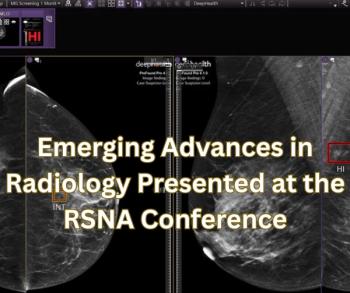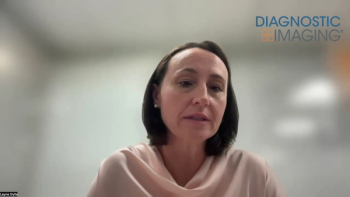
Breast elastography moves closer to clinical mainstream
Judging by recent large clinical trials on two different imaging platforms, breast ultrasound elastography is moving closer to mainstream use as a means of helping prevent biopsies of benign lesions.
Elastography refers to the measurement of elastic properties of tissues. On elastography images, obtained while the region of interest is compressed, malignancies appear to be larger relative to conventional ultrasound images.
Although ultrasound elastography has mostly proven itself for masses, it is also promising for evaluating suspicious microcalcifications picked up during screening mammography, according to studies out of Korea.
In one study at Seoul National University, conventional ultrasound and real-time freehand elastography images were obtained on the EUB-8500 scanner from Hitachi Medical Systems. Researchers examined results for 50 women who underwent ultrasound-guided biopsy, including 25 ductal carcinoma in situ lesions and 25 fibrocystic changes.
Dr. Nariya Cho, a clinical assistant professor of radiology, and colleagues used color indications of stiffness and softness, rather than lesion size, to determine malignancy, rendering it unnecessary to see and measure a lesion.
Elastography video clips were shown in random order to different radiologists who were blinded to the mammography results and pathology findings. These radiologists then rated the elastography images for likelihood of malignancy. Elastography achieved 96% sensitivity, 68% specificity, a 75% positive predictive value, and a 94% negative predictive value.
“In the near future, ultrasound elastography has the potential to improve the accuracy of gray-scale ultrasound detection and differentiation of breast lesions associated with suspicious microcalcifications,” Cho said at the 2007 RSNA meeting.
In another study of 130 cases (80 benign and 50 malignant) presented by the Korean team, three radiologists had moderate to substantial interobserver agreement and substantial to perfect intraobserver agreement. The malignant cases included 36 invasive cancers and 16 DCIS lesions. Results did not differ by lesion size, the researchers said.
In a six-site trial testing real-time freehand ultrasound elastography on the Siemens Antares unit, sensitivity averaged 98.2%, whereas specificity ranged from 67% to 95%, with an average of 85%. Radiologists were more likely to classify benign lesions as malignant when the lesion blended in with dense breast tissue on elastography images, making it difficult to make accurate size measurements, said Dr. Richard Barr, a professor of radiology at Northeastern Ohio Universities College of Medicine in Rootstown.
Newsletter
Stay at the forefront of radiology with the Diagnostic Imaging newsletter, delivering the latest news, clinical insights, and imaging advancements for today’s radiologists.




























